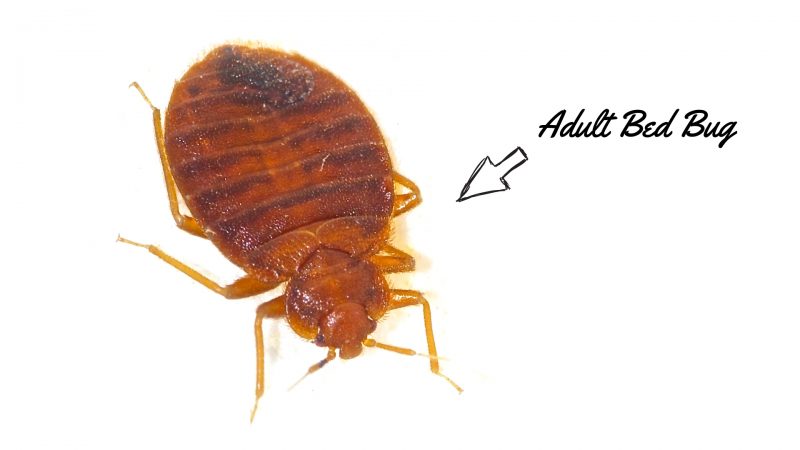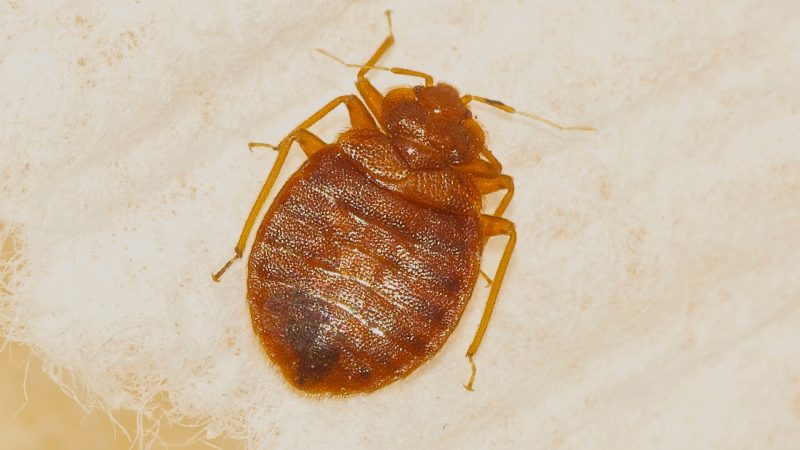The worst thing about bed bugs is the fact that it is really hard to spot these annoying creatures with the naked eye. You will be able to see the bed bugs but only if you truly focus on finding them or if there are a lot of bed bugs. In all the other cases, the chances are high that you won’t even notice them crawling through your house.
So, how big are bed bugs? Bed bugs have different life stages. They will have a different size during every single one of those stages. However, a full adult bed bug can be around 0.18 inches long (about 4.5 mm). That is, roughly, the size of an apple seed, except for the fact that bed bugs are actually flat.
The size of these insects is definitely an important feature that you should be aware of. Let’s take a closer look at how the size of bed bugs changes throughout their lives.
The Appearance of Bed Bugs
You would need to know what these insects actually look like in order to determine whether or not the creature in front of you is an actual bed bug or not.

Bed bugs have six legs and two antennae. Their oval-shaped body can have different colors, depending on their age and whether the creature is full or not. However, in most cases, bed bugs are reddish-brown. The absolute majority of the nymphs (young bed bugs) are translucent.
If you want to become a real expert in bed bugs, then you should know that their antennae have four parts. They also have ‘wings’ that are not good enough to be used for flying. Moreover, bed bugs have short gold-colored hairs (the chances are high that you won’t be able to see those without a microscope) and they also have a musty-sweetish odor.
The appearance of bed bugs can change if the insect had recently had a meal. Usually, the body of an adult is flat, but after the bed bug had eaten, its abdomen will change shape and the whole body will look longer.
The Life Cycle of Bed Bugs
The bed bug life cycle is relatively complex. You would expect bed bugs to have a short lifespan (just like the majority of other insects). But the truth is that these creatures live for around 10 months. However, some experts suppose that these insects can live for a whole year!
And the worst part is the fact that bed bugs can survive for months without eating. So, in a nutshell, you won’t be able to get rid of these annoying creatures simply by trying to make them ‘starve to death’.
Bed bugs need to mate, in order to make the female pregnant. She can lay around 200-250 eggs in her lifetime. In most cases, the eggs are laid in crevices and cracks. These things need around 6-10 days to hatch. The eggs are usually the size of a pinhead and a pearl-white color.
Eggs
In the absolute majority of cases, the eggs of bed bugs are oval-shaped and white. The size of the eggs is around 1/16 of an inch, that’s about 1 mm (you certainly won’t be able to spot these tiny things without trying very hard).
What gets out from the eggs is called a ‘nymph’. In other words, it is a baby bed bug that can already eat blood and move. Young bed bugs are translucent or whitish-yellow. If the creature hadn’t eaten for a while, it might be invisible to the eye because of its small size and color.
Nymphs shed their exoskeletons 5 times. These insects need to eat before each molt; otherwise, they won’t be able to get rid of the exoskeleton. Because of that, there are five nymph stages, and the sizes of the bed bugs during each stage differ a bit.
Nymphs (Immature Bed Bugs)
In the table below is the bed bug nymph size chart for every stage of their development:
| Nymph Stage | Size (Inches) | Size (mm) |
| First | 0.059 | 1.5 |
| Second | 0.078 | 2 |
| Third | 0.098 | 2.5 |
| Fourth | 0.118 | 3 |
| Fifth | 0.177 | 4.5 |
After the shedding, nymphs transform into adult bed bugs. These creatures have a flat, oval body that is usually a reddish-brown color. However, as soon as it has had a blood meal, its color will change to a purplish-red. Then it will become bigger and the body will have a cigar-like shape.
Adult Bed Bugs
The size of mature bed bugs depends on a few factors. That’s why they can be anywhere between 1/4’’ to 3/8’’ long (that’s around 5-9 mm) in size.
How Big Are Bed Bugs After They Bite You?
Bed bugs change their color and shape after they bite you. These creatures can probe your skin a couple of times before finding the ‘perfect’ spot. After that, these insects will suck your blood for about 5-10 minutes.
Before the meal, the bed bug was a flat creature that could move relatively fast. However, it can consume blood up to 3 times its body weight! That means that after the blood meal, the bed bug will not only become bigger but also heavier. So, this means that these insects need more time to get back to their safe homes.
A bed bug that had just eaten can be 0.236-0.354 inches (6-9 mm) long. Bed bugs need to digest all the food in their hiding spots. Gradually, these creatures will return to their normal size.
How to Find Bed Bugs in Your House?

These insects are nocturnal creatures that prefer to get out of their hiding spots at night when they are asleep. However, the truth is that even if you are awake, it would be extremely difficult for you to spot these tiny insects in the dark.
You should also remember that not all bed bugs are big. Adults can have a relatively long body that you would be able to notice without too much effort. But nymphs also leave the hideaways at night because just like the grown-ups, they also need blood in order to survive.
Depending on the stage that the nymph is going through, its size would differ a bit. But it goes without saying that young bed bugs are much smaller than fully-grown insects.
Moreover, their color also differs. While the adults are reddish-brown, nymphs can be completely translucent or yellowish, which makes spotting them even more challenging.
Another thing that doesn’t make our lives much easier is – bed bugs can sometimes be confused with mites, swallow bugs, and bat bugs. So, even if you manage to see a bed bug crawling (after all, these things certainly are visible to the naked eye, the chances are high that you won’t be able to distinguish a bed bug from other insects on your own with 100% certainty.
List of Sources
Bed Bugs Appearance and Life Cycle, United States Environmental Protection Agency
How to Identify a Bed Bug Infestation, Virginia Department of Agriculture and Consumer Services
Diseases & Conditions – Bedbugs, Mayo Clinic
- How to Get Rid of Copperheads | Practical Guide - August 27, 2023
- How to Get Rid of Corn Snakes | What Makes Them Aggressive? - August 27, 2023
- How to Get Rid of Alligators | Safety Measures and Removal Methods - July 16, 2023
